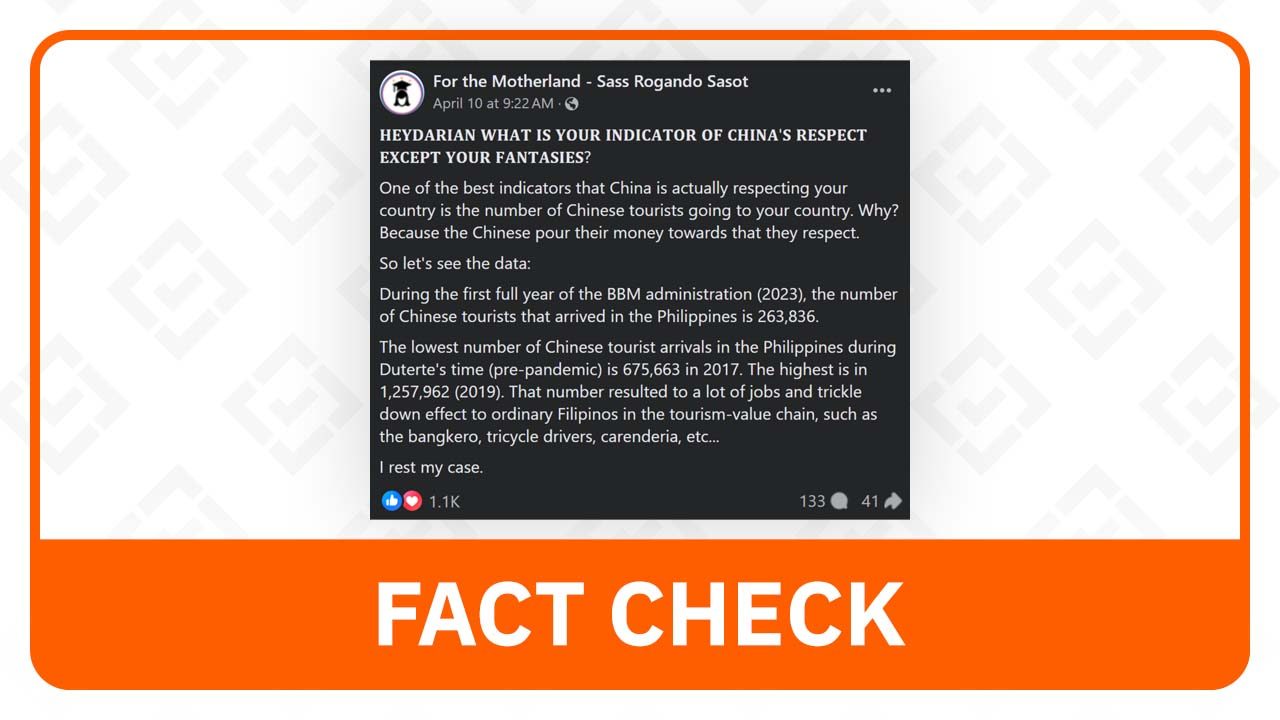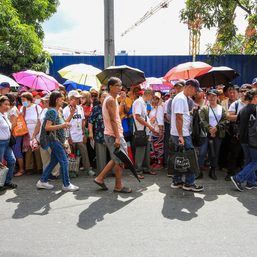SUMMARY
This is AI generated summarization, which may have errors. For context, always refer to the full article.

Claim: The number of Chinese tourists in the Philippines under President Ferdinand Marcos Jr.’s administration dropped compared to under former president Rodrigo Duterte.
Rating: MISSING CONTEXT
Why we fact-checked this: The Facebook post was made by pro-Duterte blogger Sass Sasot on April 10. As of writing, it has gained 1,100 reactions, 133 comments, and 41 shares.
The post pointed out that in 2023, during the first full year of the Marcos administration, the number of Chinese tourists in the Philippines was 263,836. Meanwhile, the lowest number of Chinese tourist arrivals under Duterte’s term pre-pandemic was 675,663 in 2017, Sasot claimed.
The post was uploaded amid an ongoing word war between Marcos and Duterte related to the supposed “gentleman’s agreement” between Duterte and China over sovereign rights in the West Philippine Sea.

The bottom line: While it is true that the number of Chinese tourists in 2023 is lower compared to Chinese tourist arrivals under Duterte’s term before the pandemic, the post fails to contextualize the lower figures.
Before the COVID-19 pandemic was declared in 2020, the Philippines drew 1,743,309 Chinese tourists in 2019; 1,257,962 in 2018, and 968,447 in 2017 (Sasot’s post erroneously said 675,663 Chinese tourists were recorded in 2017).
Air travel restrictions due to the pandemic curbed the number of tourist arrivals: in 2020, only 170,432 Chinese tourists arrived in the Philippines, with the figure dropping to 9,674 in 2021.
In October 2022, the Philippines further eased stringent travel restrictions, no longer requiring COVID-19 tests for fully vaccinated travelers. That year, the number of Chinese tourist arrivals was at 39,627, increasing to 263,836 in 2023.
Aside from entry restrictions at the Philippine borders, China too imposed its own outbound tourism restrictions affecting the foreign travels of its citizens for three years. It was only in early 2023 that China relaxed its inbound and outbound travel restrictions and resumed outbound group tours for its citizens.
Fewer Chinese tourists: The Philippines is not the only country experiencing fewer visits from Chinese tourists. The same problem can be seen in other Southeast Asian countries also reliant on Chinese tourism, such as Thailand, Cambodia, and Vietnam.
Aside from the later reopening of China’s outbound travel, Nikkei Asia reported that the slumping real estate market and worsening labor market also affected Chinese holidaymakers’ spending habits. Additionally, Chinese tourists are also preferring cheaper domestic trips over more expensive international travel.
The Philippines hopes to bring the number of tourist arrivals to pre-pandemic levels following a 235% increase in Chinese visitors in the first two months of 2024.
ALSO ON RAPPLER
- Newsbreak Chats: How gov’t officials, big operators conspired vs fisherfolk
- Water district warfare: Takeovers, ‘politicking,’ standoffs at Cebu water firm
- Filipinos can push to deport foreign exes based on immigration violations
Marcos vs Duterte: The Facebook post comparing the Marcos and Duterte administrations and their relationship with China surfaced following reports of a “secret deal” between Duterte and China to stop bringing construction materials to repair Philippine facilities in the West Philippine Sea.
The former president claimed to have agreed with Chinese President Xi Jinping to keep the status quo in the region only, but maintained that nothing was conceded to China. Marcos said he was “horrified” by the alleged secret deal and urged his predecessor to clarify details of the supposed agreement. ([OPINION] Marcos’ disengagement from Duterte sets stage for 2025 showdown)
Rappler has already published multiple fact-checks regarding the Marcos administration’s relationship with China:
- FACT CHECK: Marcos’ EO 57 not a declaration of war on China
- FACT CHECK: No Marcos declaration of war vs China over West PH Sea incidents
- FACT CHECK: No Marcos order expelling China from West PH Sea
– Kyle Marcelino/Rappler.com
Kyle Marcelino is a graduate of Rappler’s fact-checking mentorship program. This fact check was reviewed by a member of Rappler’s research team and a senior editor. Learn more about Rappler’s fact-checking mentorship program here.
Keep us aware of suspicious Facebook pages, groups, accounts, websites, articles, or photos in your network by contacting us at factcheck@rappler.com. You may also report dubious claims to the #FactsFirstPH tipline by messaging Rappler on Facebook or Newsbreak via Twitter direct message. You may also report through our Viber fact check chatbot. Let us battle disinformation one Fact Check at a time.
Add a comment
How does this make you feel?





![[In This Economy] Marcos’ POGO ban is popular, but will it work?](https://www.rappler.com/tachyon/2024/07/thought-leaders-marcos-pogo-ban.jpg?resize=257%2C257&crop=255px%2C0px%2C720px%2C720px)
![[Rappler Investigates] POGOs no-go as Typhoon Carina exits](https://www.rappler.com/tachyon/2024/07/newsletter-graphics-carina-pogo.jpg?resize=257%2C257&crop=424px%2C0px%2C1080px%2C1080px)







![[OPINION] Rodrigo Duterte and his ‘unconditional love’ for China](https://www.rappler.com/tachyon/2024/04/rodrigo-duterte-xi-jinping-august-2019.jpeg?resize=257%2C257&crop=91px%2C0px%2C900px%2C900px)


![[The Slingshot] Lito Patay’s 4 hours and 38 minutes of infamy](https://www.rappler.com/tachyon/2024/07/Lito-Patay-4-hours-infamy-July-19-2024.jpg?resize=257%2C257&crop=233px%2C0px%2C720px%2C720px)
There are no comments yet. Add your comment to start the conversation.